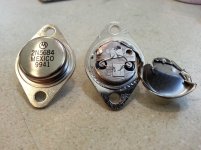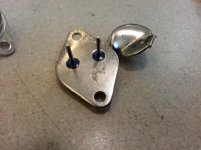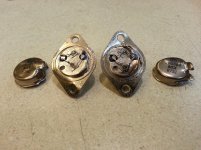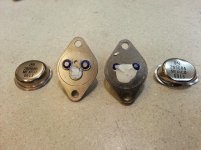NONEED TOSORRYING.THREAD ERFUN BY BYThey are still a completely unknown part (= garbage). Sorry.
-Chris
Do you see double somehting, if so than go where need notingtowaste here thats amerian or nasa thingAndrew...
Why are you wasting our time by posting Duplicate images that don't reside on the DiyAudio server ???

If your info is correct, the transistors are probably output types for car radios.
Possibly germanium such as OC35, AD149
Check with a transistor tester

What did I do wrong?Andrew...
Why are you wasting our time by posting Duplicate images that don't reside on the DiyAudio server ???
how older> so betetr such as wine, best bolted contact u can check or serch reserch nasa m, nearest cu hi current indsutria types and so on, just found all 12 high weigt onhand xxx parts.now only for art and dive on look and gold?plated pins ...ciao ciao
Here I have bought it because it is still in stock, but when gone we get no new lead solder again but the new leadfree, then I have to go over also, I have still some 3 kilo so use that until it is out of stock.
regards
What did I do wrong?
do nt miss thread theme, focus on the lead solder pb or pb free in other thread if not exist.
What did I do wrong?
Hi Andrew. I was referring to your post #800 photos being offsite.
They were Suzyj's pics showing the moulding pips/marks etc.Hi Andrew. I was referring to your post #800 photos being offsite.
Rather than refer to another post, while I was talking about what I could see on my devices, I repeated her pics so that Members could see what I was talking about.
But I see what you mean:
It is poor practice to use a remote server for pics and attachments that could eventually get "lost".
Ask Suzyj to attach her pics to the Forum.
2N5684/6 - Bad or OK?
I just received some 2N5684 and 2N5686 transistors from UT Source and would like your opinions. The first thing that I noticed is that there is some pitting on the bottom side of the transistors. The markings came off easily with isopropyl alcohol, so I cut the cap off of one to see inside. There are two parallel dies inside, however, I have seen this in genuine Motorola transistors as well. They do look pretty beefy, so I'm not sure if they are good transistors or not. What do you think?
Take care,
Doug
I just received some 2N5684 and 2N5686 transistors from UT Source and would like your opinions. The first thing that I noticed is that there is some pitting on the bottom side of the transistors. The markings came off easily with isopropyl alcohol, so I cut the cap off of one to see inside. There are two parallel dies inside, however, I have seen this in genuine Motorola transistors as well. They do look pretty beefy, so I'm not sure if they are good transistors or not. What do you think?
Take care,
Doug
Attachments
I don't see how parallel dies could work. The die with the higher B (static current gain) will take more current -> will get warmer -> will increase its B -> will take even more current -> will get even warmer … and so on. In the end the die with the higher B will take most of the load. That's why you need emitter resistors if you want to run power transistors in parallel.There are two parallel dies inside, however, I have seen this in genuine Motorola transistors as well.
Therefore: fake.
I don't see how parallel dies could work. The die with the higher B (static current gain) will take more current -> will get warmer -> will increase its B -> will take even more current -> will get even warmer … and so on. In the end the die with the higher B will take most of the load. That's why you need emitter resistors if you want to run power transistors in parallel.
Therefore: fake.
That is exactly what I would have thought too, but I have an old 80's vintage Motorola transistor of the same type that recently failed in an amplifier, and it has parallel dies as well. I believe that this transistor was manufactured many years before fakes were a thing, so I am a bit confused over seeing this.
Has anybody else ever seen pitting on the bottom of genuine Motorola transistors, like you can see near the leads in the second photo in my previous post?
Take care,
Doug
See if you can find any Motorola information on how they build up the baseplate.
The copper slug in the middle usually fits through a hole in the steel plate. But your version seems to be different. It looks like a copper slug soldered to the top of the steel baseplate. Motorola should confirm this transistor was manufacturered that way.
The copper slug in the middle usually fits through a hole in the steel plate. But your version seems to be different. It looks like a copper slug soldered to the top of the steel baseplate. Motorola should confirm this transistor was manufacturered that way.
What has me wondering is the sloppy layout of the dies and the atrocious bond of the one wire on the upper chip. I worked in a thin film lab for 2 summers back while at Uni, and any work like that would have been considered total reject.
The bottom of the one case is really suspicious.
The dome is also unusual in that Motorola tended to use an aluminium dull finished dome on most of their power transistors. Depending on the vintage, most Motorola TO3 cans were stamped with the UNCIRCLED M.
The bottom of the one case is really suspicious.
The dome is also unusual in that Motorola tended to use an aluminium dull finished dome on most of their power transistors. Depending on the vintage, most Motorola TO3 cans were stamped with the UNCIRCLED M.
Below are the two transistors that failed in an amplifier after well over twenty years of service. I have a couple more amplifiers using these exact devices from 1987 that are still functioning just fine. In my opinion these transistors are almost certainly genuine, and they do have the circled "M" on the cap as well. They are almost identical inside as the new one posted previously, although the dies are aligned a bit better. I did damage the bottom die on the new device when removing the cap, so please ignore that.
The only thing that makes me suspect them as counterfeit is the pitting on the bottom of the base plate, but I think that it would be unlikely that someone would go to this much trouble to make such a close copy of the internal die arrangement for a fake transistor.
I am also including a picture of two very obvious fakes recently purchased from eBay. One has the smaller diameter pins, the dies are both way too small, the date codes are too recent for these types from Motorola, and the base plates are completely different.
Take care,
Doug
The only thing that makes me suspect them as counterfeit is the pitting on the bottom of the base plate, but I think that it would be unlikely that someone would go to this much trouble to make such a close copy of the internal die arrangement for a fake transistor.
I am also including a picture of two very obvious fakes recently purchased from eBay. One has the smaller diameter pins, the dies are both way too small, the date codes are too recent for these types from Motorola, and the base plates are completely different.
Take care,
Doug
Attachments
I don't see how parallel dies could work. The die with the higher B (static current gain) will take more current -> will get warmer -> will increase its B -> will take even more current -> will get even warmer … and so on. In the end the die with the higher B will take most of the load. That's why you need emitter resistors if you want to run power transistors in parallel.
Therefore: fake.
I recall a discussion we had a few months ago relating the most powerful devices available. It was shown that a manufacturer doubled the ratings of some devices by just doubling the dies inside the case. So I'd say the existence of two dies doesn't stringently lead to the conclusion that the device must be fake.
Best regards!
Two years ago I had the same discussion with the manufacturer of a 5,000,000 $ mass spectrometer. They used MJ11030 (300W, TO3) darlington transistors "made" by New Jersey Semiconductor:
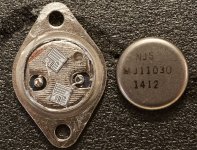
I told them that I think these transistor are fake, they told me that parallel dies are ok …
Fun fact: If you read the data sheet (by ON or even by NJS), it sais:
"Monolithic construction with built-in base-emitter shunt resistor".
"Monolithic" to me means: One die. Not two.

I told them that I think these transistor are fake, they told me that parallel dies are ok …
Fun fact: If you read the data sheet (by ON or even by NJS), it sais:
"Monolithic construction with built-in base-emitter shunt resistor".
"Monolithic" to me means: One die. Not two.
Both the 2N568x and MJ1103x series devices have relatively poor SOA at high voltage (drops like a stone at 30V). Likely due to current hogging by one die. Second breakdown is a current hogging mechanism within the die - made worse by voltage. Paralleling dies can't help that situation. They seem to be doing that with their 50 amp transistors - it may be the only way to get a decent beta at 50A, and the single bond wire is probably only good for 25 or 30.
For a while ON was making a version of the 15024 rated at 300 or 400 watts - with two 15024 dies in it. They are not making them anymore - there is probably a reason.
For a while ON was making a version of the 15024 rated at 300 or 400 watts - with two 15024 dies in it. They are not making them anymore - there is probably a reason.
I am beginning to think that these double-die Motorola/ON transistors are real (or maybe fake by design …)
The MJ11032 might be a double-die version of the MJ11016. If you compare a MJ11032 (50A, 120V, 300W) with a MJ11016 (30A, 120V, 200W), you will see that they both drop very steeply above ~35V and that the MJ11032 (blue) is always ~50% above the MJ11016:
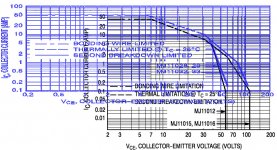
But I still don't understand how they avoid current hogging or uneven current distribution. Are the dies matched?
The MJ11032 might be a double-die version of the MJ11016. If you compare a MJ11032 (50A, 120V, 300W) with a MJ11016 (30A, 120V, 200W), you will see that they both drop very steeply above ~35V and that the MJ11032 (blue) is always ~50% above the MJ11016:

But I still don't understand how they avoid current hogging or uneven current distribution. Are the dies matched?
- Home
- Design & Build
- Parts
- My Transistors, original or copy?
